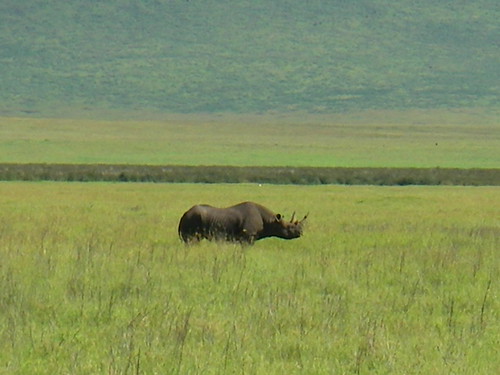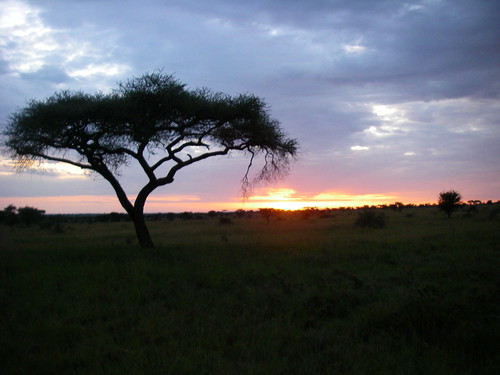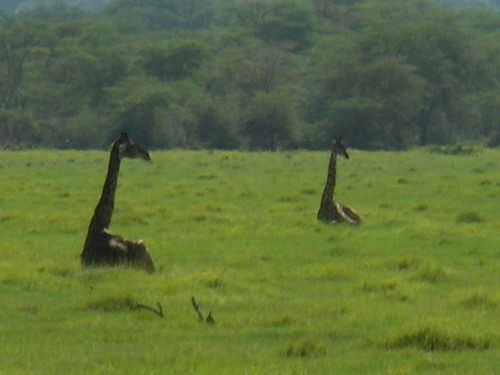 After so many different types of landscapes, from lava fields and deserts to lush rain forests and swampy lakes, to grassy plains, we were shocked at the beauty of the massive caldera. After a 600 meter decent down muddy roads, we emerged into the crater's emerald green landscape. The first thing we noticed was the dense pink line of flamingos that were arrayed along the edge of the lake. The green grasses make it easier to spot wildlife, and it wasn't long before we spotted one of the elusive 'big 5'-- a black rhino. We saw three rhinos that day of only nine that stay in the crater. We saw a solo male lion that was causing some disturbance among the grazing wildebeest and thompson's gazelle. And we saw some sacred ibis and hippos on land, as well as solo male elephants, a phenomenon that only happens in the crater.
After so many different types of landscapes, from lava fields and deserts to lush rain forests and swampy lakes, to grassy plains, we were shocked at the beauty of the massive caldera. After a 600 meter decent down muddy roads, we emerged into the crater's emerald green landscape. The first thing we noticed was the dense pink line of flamingos that were arrayed along the edge of the lake. The green grasses make it easier to spot wildlife, and it wasn't long before we spotted one of the elusive 'big 5'-- a black rhino. We saw three rhinos that day of only nine that stay in the crater. We saw a solo male lion that was causing some disturbance among the grazing wildebeest and thompson's gazelle. And we saw some sacred ibis and hippos on land, as well as solo male elephants, a phenomenon that only happens in the crater.
We had a hair-raising drive out of the crater trying to beat the worst of the afternoon rains, with lots of sliding along the narrow and recently packed clay roads. Safaris are supposed to be an adventure, right?
On the drive back to Arusha safe and sound, we stopped at the world-famous archaeological site Oldavi, one of the most significant sites for tracing human evolution. Pretty cool. After all the excitement, we decided to rest for a couple of days before part two of our big African adventure--climbing Kilimanjaro. We start the six-day climb tomorrow--wish us luck!
-k & d
Sunday, March 16, 2008
Safari: Episode 4
Saturday, March 15, 2008
Safari: Episode 3
 We woke very early in the morning for a drive through the Serengeti. Although we weren't optimistic about seeing many animals because we were north of the great migration, we still saw thousands of grazers. We came across a huge herd of zebra, slowly cuing and winding their way south. We also saw wildebeest (oddly cute), who like to co-mingle with zebras to enhance security. Apparently wildebeest have the good hearing and zebras have the good eyesight in the relationship. We were really excited to see three female lions roaming around the bush in search of some shade. They seemed pretty non-plussed by the vehicles and the tourists snapping photos as they wandered about. Later in the afternoon, we saw a second group of three female lions. We miss our cats.
We woke very early in the morning for a drive through the Serengeti. Although we weren't optimistic about seeing many animals because we were north of the great migration, we still saw thousands of grazers. We came across a huge herd of zebra, slowly cuing and winding their way south. We also saw wildebeest (oddly cute), who like to co-mingle with zebras to enhance security. Apparently wildebeest have the good hearing and zebras have the good eyesight in the relationship. We were really excited to see three female lions roaming around the bush in search of some shade. They seemed pretty non-plussed by the vehicles and the tourists snapping photos as they wandered about. Later in the afternoon, we saw a second group of three female lions. We miss our cats.
In late afternoon, we drove out of the Serengeti to the adjacent Ngorogoro Crater conservation area to set up camp on the rim of the crater (technically a caldera). This campsite was overrun with giant stork, who look like creepy old men. It also seemed a favorite spot for elephants and zebras to walk through.
After dinner, we were honor-bound to buy Julius a drink for being the first of us to spot lions that day (of course, we didn't argue his advantage in having the radio where guides are cluing each other in about where the animals are). We drove to a local bar that caters to drivers and rangers and had a beer after a long and dusty day. After a fun conversation about American politics--George W recently paid a visit to Tanzania and every African we've met is really excited about Barak Obama even if they don't really consider him black-- we drove back to camp. This was the impromptu night safari part of the trip where we saw water buffalo really close for the first time (we almost hit one in the road), as well as zebra, giraffe, elephant, and mongoose. Did we mention there are a lot of animals to be seen?
-k & d
Friday, March 14, 2008
Safari: Episode 2
 On the second day's drive to the Serengeti, Julius gave us the option of taking the direct route, or the longer route through the great rift valley and past an active volcano and many Masai tribe settlements. We decided on the second route, and to our surprise the active volcano decided to erupt just as we passed it. What was wondrous to us just seemed to disappoint the villagers near the volcano who have lost a lot of grazing land and tourist business because of the volcano. Volcanoes: cool but inconvenient.
On the second day's drive to the Serengeti, Julius gave us the option of taking the direct route, or the longer route through the great rift valley and past an active volcano and many Masai tribe settlements. We decided on the second route, and to our surprise the active volcano decided to erupt just as we passed it. What was wondrous to us just seemed to disappoint the villagers near the volcano who have lost a lot of grazing land and tourist business because of the volcano. Volcanoes: cool but inconvenient.
Anyhoo, the drive was long but worth it. We arrived at the gate of the Serengeti in late afternoon, and made the slow game drive south to our campsite. Serengeti is the Masai word meaning "endless plains." It's hard to describe how vast and endless the Serengeti seems. With the exception of a few acacia trees, it seems like you can see the curves of the earth at the ends of the tall grasses that surround you. It's perfect grazing land for many antelope. New varieties we saw included grant's gazelle, thompson's gazelle, topi, hartebeast (unofficially the ugliest antelope), waterbuck, and steenbok. We also saw herds of zebra and wildebeast, stragglers in the great migration, which was mostly south of where we were this time of year. We also saw some warthogs--strangely endearing, as well as Julius' favorite animal.
After a long day's drive, we pulled into the campsite, which was the most primitive of all the campsites. Shortly after the sun set, we realized the reason for all the signs warning people not to stray past the camp circle, as we glimpsed jackals and heard lions roaring not far away. Strangely, falling asleep wasn't difficult, but Dennis did hesitate about getting up to pee in the middle of the night.
-k & d
Thursday, March 13, 2008
Come on and Safari with Me: Episode 1
 We spent two days in the small city of Arusha, dodging people who were desperately trying to sell us safaris, batiks, gems, or whatever else in the low season. In short, Arusha has all the lack of charm of that other tourist town, Siem Reap, but none of the delicious fruit shakes. But rather than focus on the glue sniffers, touts, dusty streets, and other negatives, we should focus on the wonderful four-day safari that we booked in Arusha.
We spent two days in the small city of Arusha, dodging people who were desperately trying to sell us safaris, batiks, gems, or whatever else in the low season. In short, Arusha has all the lack of charm of that other tourist town, Siem Reap, but none of the delicious fruit shakes. But rather than focus on the glue sniffers, touts, dusty streets, and other negatives, we should focus on the wonderful four-day safari that we booked in Arusha.
Friday, March 7, 2008
Riding the Tazara Rails
 When planning our trip through Africa, we had always kept a little gap in the 'how are we going to get from Zambia to Tanzania' column. The information online is scant at best with a combination of horror stories about busses, chicken buses and trains. The basic gist of our earlier research into the (in)ability to get from Lusaka to Dar Es Salaam was the each mode of transport would breakdown or crash. Every time.
When planning our trip through Africa, we had always kept a little gap in the 'how are we going to get from Zambia to Tanzania' column. The information online is scant at best with a combination of horror stories about busses, chicken buses and trains. The basic gist of our earlier research into the (in)ability to get from Lusaka to Dar Es Salaam was the each mode of transport would breakdown or crash. Every time.
Monday, March 3, 2008
Lusaka, J-town, No Pictures Allowed
 Lusaka, apart from being the capital of Zambia and containing the tallest building in Zambia, is the only place to get a guaranteed Tanzanian visa. Getting one on the train at the border seems, by all accounts, “difficult.” So, we decided to spend a few days here getting our paperwork sorted and exploring the city.
Lusaka, apart from being the capital of Zambia and containing the tallest building in Zambia, is the only place to get a guaranteed Tanzanian visa. Getting one on the train at the border seems, by all accounts, “difficult.” So, we decided to spend a few days here getting our paperwork sorted and exploring the city.
As we have discovered all along this trip, it helps to know a local to get out of the Lonely Planet rut. Enter Jonathan Kays from couchsurfing.com. He graciously invited us to stay with him for as long as a month . Although somewhat short of a month, we spent five days with the ever-busy Jonathan showing us around the city and even introducing Kristi and I to his family. We have had the opportunity to hang out in compounds with Jonathan, go to nightclubs, meet many new people and generally have a city experience unlike any yet on this trip. The opportunity to see the full range of the city experience, from ghettoes to shiny new shopping centers and feel welcomed everywhere has been quite heartwarming. Plus, in a strange turn of events, I ended up seeing a gentleman that I met playing pool in Linda compound the night before at the bus station (15 km away) the next day. So, even in a city with over a million people, sometimes it can still operate like a small town.
One note of caution for visiters to Lusaka, DO NOT try to take a picture of the tallest building in Lusaka from the parking lot of the Citibank building. A bullying, yet unarmed, man will drag you to a sweet man with a submachine gun to let you know (after perusing your goofy vacation photos) that pictures are off limits. Nothing like a grinning man with a shiny gun cutting you a break for photographing landmarks.
-dSaturday, March 1, 2008
Victoria Falls, It’s Outta Sight (or The Zim Zam Shuffle)
 When planning this trip, one of the places both Kristi and I were most excited to see was Victoria Falls. I'll get one thing out of the way first, it is amazing. We were lucky enough to arrive in the middle of an especially bad rainy season upriver along the Zambezi. The upstart of this is that the experience of the falls is less about just looking and more about being in the falls. Any attempt to prevent a full soaking is a joke. The ponchos, they do nothing. The falls split Zimbabwe from Zambia which affords the opportunity to get two distinct views of the falls.
When planning this trip, one of the places both Kristi and I were most excited to see was Victoria Falls. I'll get one thing out of the way first, it is amazing. We were lucky enough to arrive in the middle of an especially bad rainy season upriver along the Zambezi. The upstart of this is that the experience of the falls is less about just looking and more about being in the falls. Any attempt to prevent a full soaking is a joke. The ponchos, they do nothing. The falls split Zimbabwe from Zambia which affords the opportunity to get two distinct views of the falls.
Zimbabwe Side: First off, Zimbabwe has not experienced the best political, social run in the last few years. Strong arm/corrupt leadership combined with a staggering 6000 percent inflation rate has made the town of Victoria Falls into a ghost town. What once served as the hub of tourism is now a crumbling small town with children attempting to sell or barter crafts with the few tourists who do come through. Not that there is a upside of political and fiscal turmoil, but one of the effects is that the park that contains the falls view is nearly empty allowing a particularly unhurried experience.
Labels: Africa, Victoria Falls, Zambia, Zimbabwe
